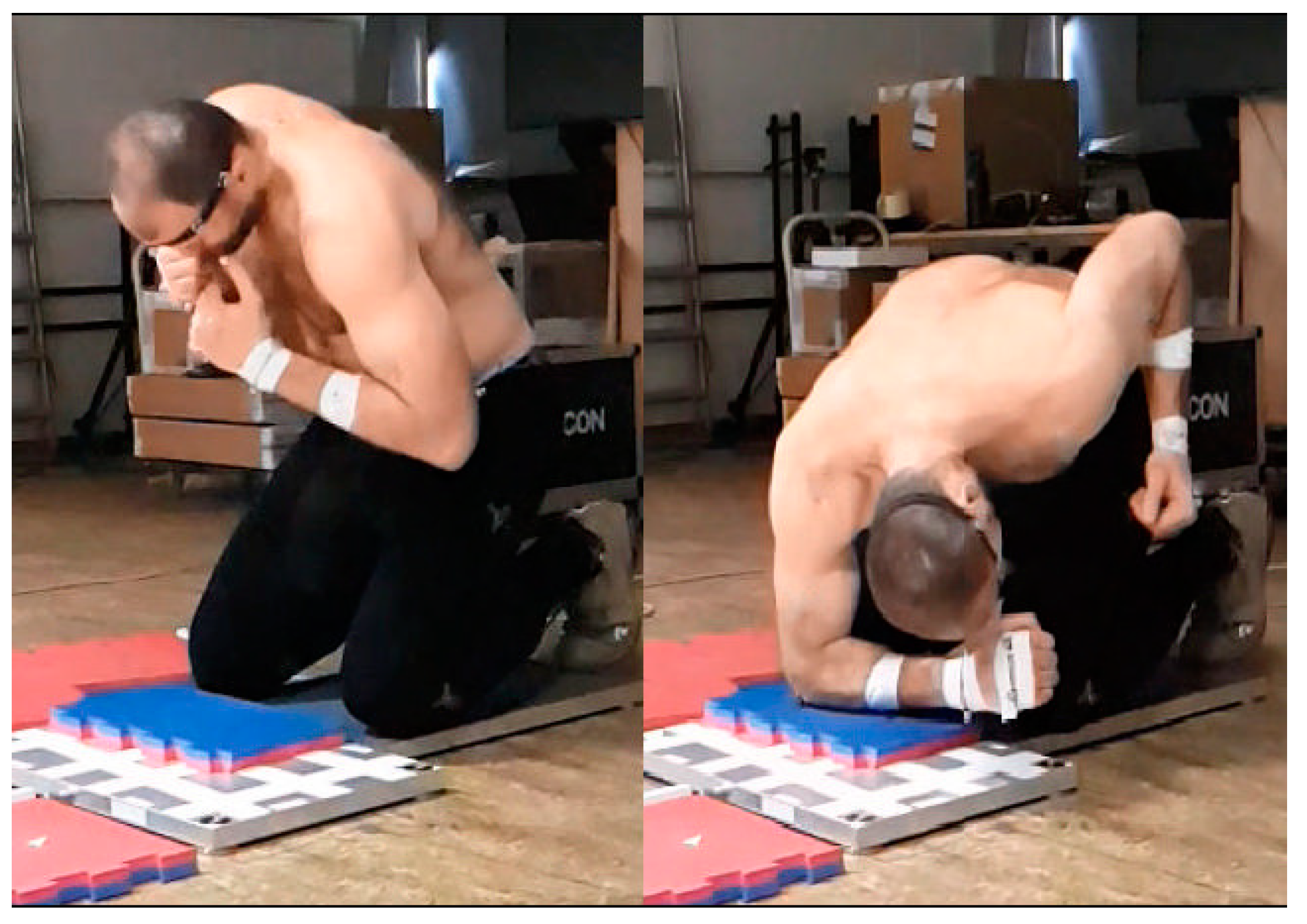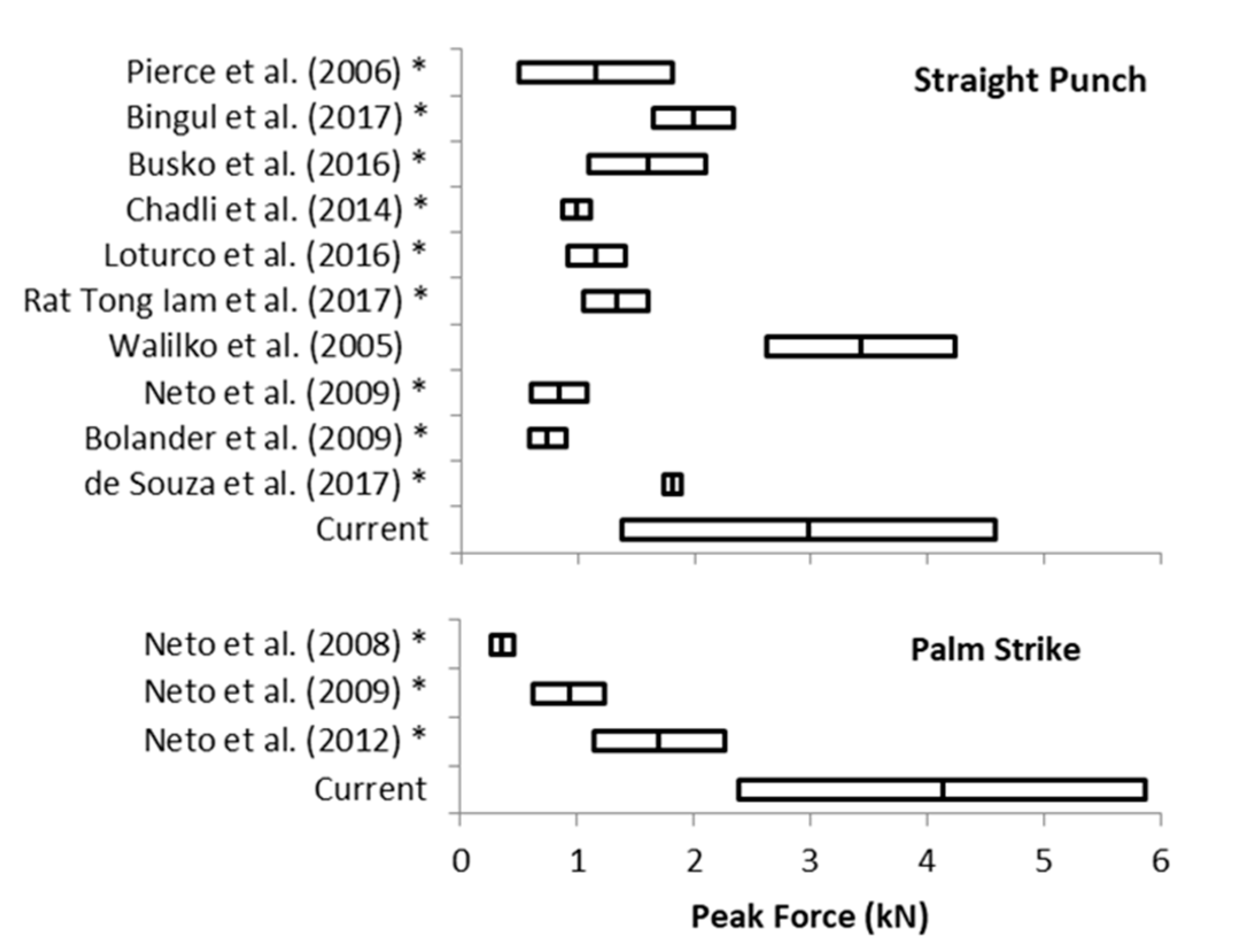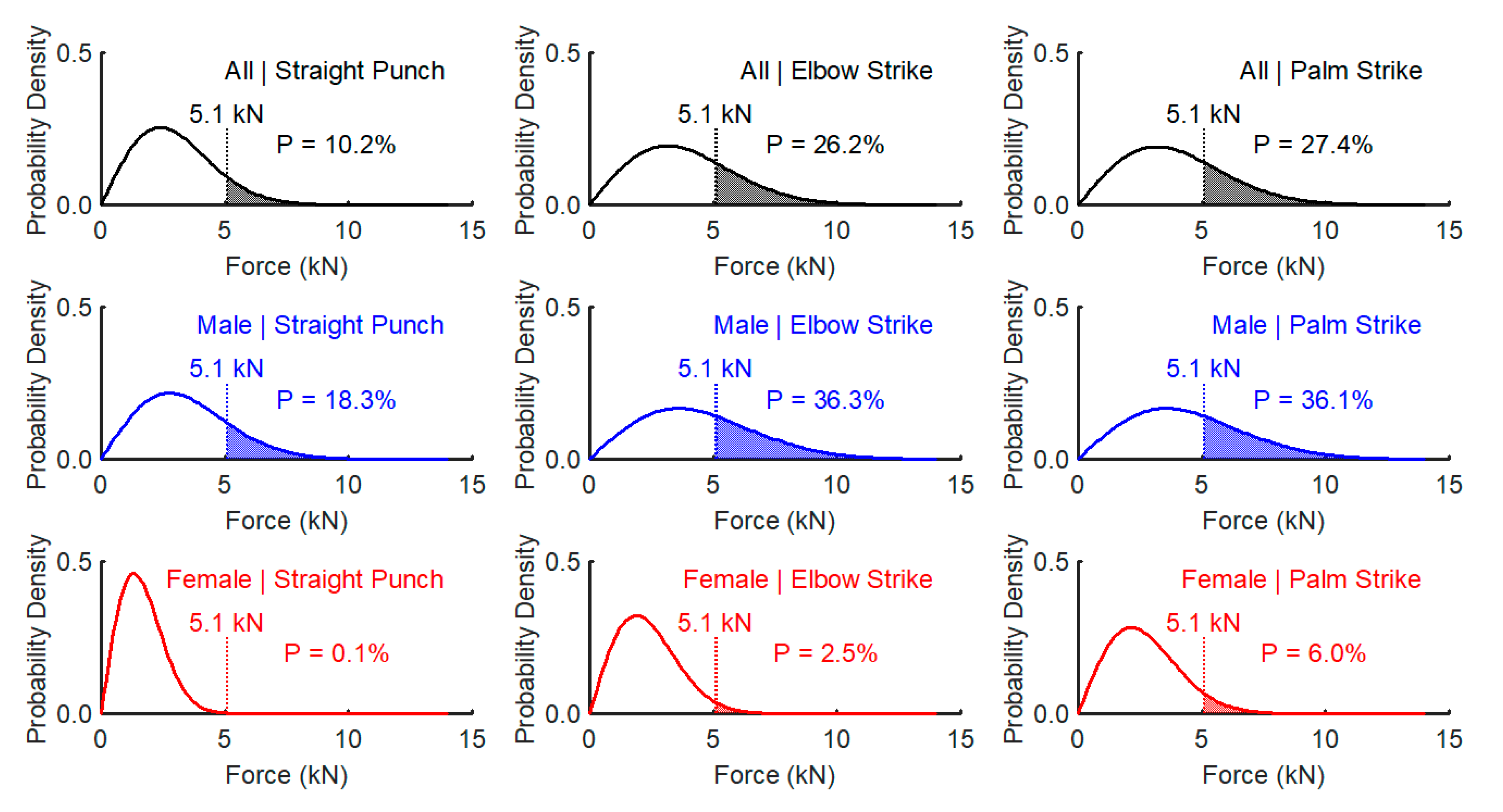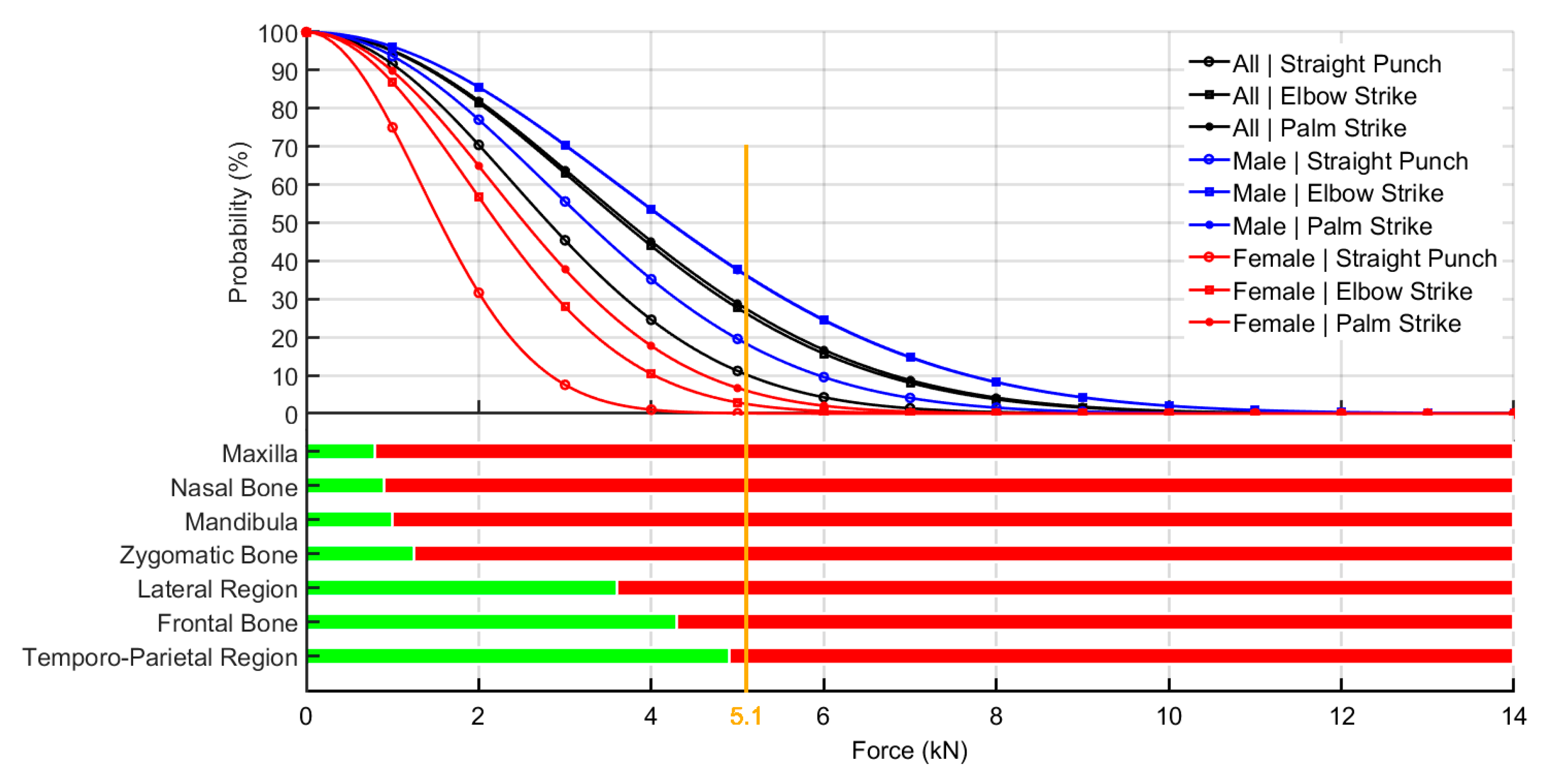Upper Limb Strikes Reactive Forces in Mix Martial Art Athletes during Ground and Pound Tactics
Abstract
:1. Introduction
2. Materials and Methods
2.1. Experimental Approach to the Problem
2.2. Participants
2.3. Procedures of Striking Action
2.4. Instrumentation and Data Acquisition
2.5. Statistical Analysis
3. Results
4. Discussion
A Limitation of the Study
5. Conclusions
Supplementary Materials
Author Contributions
Funding
Acknowledgments
Conflicts of Interest
Appendix A
| Region Bone | Study | Force Tolerance (kN) | Force Tolerance (kg) | Impact Area (cm2) | N mm−2/MPa | Weight (kg) | Velocity (m·s−1) |
|---|---|---|---|---|---|---|---|
| Frontal (forehead) | Schneider and Nahum (1972) | 4.0–6.2 | 6.5 | 1.1–3.8 | 3–6 | ||
| Advani et al. (1975) | 4.0–6.2 | 6.45 | 9.1 | 5–10 | |||
| Nahum et al. (1968) | 4.0–6.2 | ||||||
| Voigt and Thomas (1974) | 5.5 | ||||||
| Allsop et al. (1988) | 2.2–6.4 | 224–662 | |||||
| Gadd et al. (1968) | 498 | 7.58 | |||||
| Tarriere et al. (1981) | 7.7 | ||||||
| Hodgson (1967) | 4.6–8.7 | 2.5–3.3 | |||||
| Cormier et al. (2011) | 2.5–7.6 | 6.45 | 3.2 | ||||
| Temporo-parietal | Nahum et al. (1968) Allsop (1991) | 2.5–5.2 | 6.45 | ||||
| Advani et al. (1975) | 5.7 | 9.1 | 5–10 | ||||
| Hodgson (1967) | 159–454 | 0.9–7.2 | 4 | ||||
| Gadd et al. (1968) | 249 | ||||||
| Raymond et al. (2009) | 5.9 | 38.1 mm projectile | 0.10 | 18–37 | |||
| Hodgson and Thomas (1971) | 5.5 | 1.6–4.7 | |||||
| Hodgson (1967) | |||||||
| Lateral region | Schneider et al. (1972) | 2.0–3.6 | 6.5 | 1.1–3.8 | 3–6 | ||
| Nahum et al. (1968) | 2.0–3.6 | 6.45 | |||||
| Allsop et al. (1988) | 5.2 | ||||||
| Yoganandan et al. (2003) | 5.5–9.9 | 5 | 4.8–7.7 | ||||
| Occipital region | Advani et al. (1982) | 12.5 | |||||
| Allsop (1991) | 12.5 | ||||||
| Hodgson (1967) | 15.9 | 3.7 | |||||
| Stalnaker et al. (1977) | 7.1 | 15.2 cm diameter | 10 | 6.8–7.2 | |||
| Os zygomaticum | Advani et al. (1982) | 1.0 | 6.45 | ||||
| Nahum et al. (1968) | 1.0 | 1.38–4.17 | |||||
| Nyquist et al. (1986) | 0.4 | 2.54 | 2.7–7.2 | ||||
| Hodgson (1967) | 159–454 | 2.54–13.2 cm diameter | 0.9–7.2 | 4 | |||
| Gadd et al. (1968) | 225 | ||||||
| Allsop et al. (1988) | 0.8–2.4 | 90–244 | |||||
| Yoganandan et al. (1991) | 1.1–1.3 | 4 | |||||
| Gallup (1988) | 3.2–3.8 | 335–394 | |||||
| Mandibula | Nahum et al. (1968) | 1.4 | 6.45 | ||||
| Hodgson (1967) | 159–454 | 2.54–13.2 cm diameter | 0.9–7.2 | 4 | |||
| Nyquist et al. (1986) | 0.6 | 2.54 | 2.7–7.2 | ||||
| Schneider and Nahum (1972) | 2.76–6.20 | 1.1–3.8 | 3–6 | ||||
| Os nasale | Nyquist et al. (1986) | 0.3 | 306 | 2.54 | 2.7–7.2 | ||
| Hodgson (1967) | 159–454 | 2.54–13.2 cm diameter | 2.5–3.7 | ||||
| Gallup (1988) (nasal area) | 1.9–2.9 | 200–299 | |||||
| Swearingen (1965) | 0.3–4.5 | ||||||
| Nahum et al. (1968) | 0.13–0.34 | ||||||
| Maxilla | Nahum et al. (1968) Advani et al. (1982) | 0.7–1.5 | 6.45 | ||||
| Nyquist et al. (1986) | 1.4 | 2.54 | |||||
| Hodgson (1967) | 0.6–1.8 | 159–454 | 2.54–13.2 cm diameter | ||||
| Allsop et al. (1988) | 1.0–1.8 | 102–184 | |||||
| Nahum et al. (1968) Schneider and Nahum (1972) | 1.03–2.07 | 1.1–3.8 | 3–6 |
| Name of Strike | Author | F MEAN (N) | SD | Number of Subjects | Experiences |
|---|---|---|---|---|---|
| Palm strike | Neto et al. (2012) | 1706.14 | 557.03 | 7 | EXPERT: 4 MALE, 3 FEMALE |
| Neto et al. (2009) | 930.00 | 301.00 | 13 | MIX: 10 MALE, 3 FEMALE | |
| Neto et al. (2008) | 355.00 | 96.50 | 13 | EXPERT: 7 MALE; NOVICE: 6 MALE | |
| Bolander et al. (2009) | 736 | 159 | 13 | EXPERT: 10 MALE, 3 FEMALE | |
| This study (complete) | 4131.20 | 1747.03 | 91 | ADVANCED = 81 PROFESSIONAL = 10 | |
| This study (reduced) | 4121.91 | 1658.01 | |||
| Straight punch | Walilko et al. (2005) | 3427.00 | 811.00 | 7 | EXPERT, MALE |
| Rat Tong Iam et al. (2017) | 1323.30 | 278.50 | 3 | EXPERT, MALE | |
| Loturco et al. (2016) | 1152.22 | 246.87 | 15 | EXPERT: 9 MALE, 6 FEMALE | |
| Chadli et al. (2014) | 989.00 | 116.70 | 11 | EXPERT, MALE | |
| Busko et al. (2016) | 1592.50 | 507.10 | 48 | EXPERT: 21 MALE, 27 FEMALE | |
| Bingul et al. (2017) | 1987.42 | 341.95 | 10 | EXPERT, MALE | |
| Pierce et al. (2016) | 1149.20 | 665.80 | 12 | EXPERT, MALE | |
| This study (complete) | 2971.85 | 1603.80 | 91 | ADVANCED = 81 PROFESSIONAL = 10 | |
| This study (reduced) | 1445.88 |
- Allsop, D.C.; Warner, M.W.; Schneider, D.; Nahum, A. Facial impact response—a comparison of the hybrid iii dummy and human cadaver. J. Passeng. Cars 1988, 97, 1224–1240.
- Allsop, D.; Perl, T.R.; Warner, C.Y. Force/deflection and fracture characteristics of the temporoparietal region of the human head. In Proceedings of the 35th Stapp Car Crash Conference, Detroit, MI, USA, 1991; pp. 269–278.
- Advani, S.; Powell, W.; Huston, J.; Ojala, S. Human head impact response-experimental data and analytical simulations. In Proceedings of the International Conference on the Biomechanics of Impact (IRCOBI), Berlin, Germany, 1975; pp. 153–162.
- Advani, S.H.; Ommaya, A.K.; Yang, W.J. Human body dynamics; Claredon: Oxford, UK, 1982.
- Adamec, J.; Mai, V.; Graw, M.; Schneider, K.; Hempel, J.-M.; Schöpfer, J. Biomechanics and injury risk of a headbutt. Int. J. Legal Med. 2013, 127, 103–110.
- Cormier, J.; Manoogian, S.; Bisplinghoff, J.; Rowson, S.; Santago, A.; McNally, C.; Duma, S.; Bolte, J. The Tolerance of the Frontal Bone to Blunt Impact. J. Biomech. Eng. 2011, 133(2), 021004. doi: 10.1115/1.4003312, 2011.
- Schneider, D.C.; Nahum, A.M. Impact studies of facial bones and skull. In Proceedings of the 16th Stapp Car Crash Conference, Detroit, MI, USA, 1972; pp. 186–203.
- Swearingen, J.J. Tolerances of the human face to crash impact; Federal Aviation Agency, Civil Aeromedical Research Institute: Oklahoma City, OK, USA, 1965.
- Gallup, B.M.; Hallgrimson, B.H.; Cotton, C.E.; Smith, T.A.; Newman, J.A. The development of an improved ATD bead form with a frangible facial insert; LR.C.O.B.I.: Bergisch-Gladbach, Germany, 1988.
- Gadd, C.W.; Nahum, A.M.; Gatts, J.; Danford, J.P. A study of head and facial bone impact tolerances. In Proc. G.M.; Auto Safety Seminar: Detroit, USA, 1968.
- Nahum, A.M.; Gatts, J.D., Gadd, C.W.; Danforth, J.P. Impact tolerance of the face and skull. In Proceedings of the 12th Stapp Car Crash Conference, Detroit, MI, USA, 1968; pp. 302–317.
- Hampson, D. Facial injury: A review of biomechanical studies and test procedures for facial injury assessment. J. Biomech. 1995, 28(1), 1–7. doi:10.1016/0021-9290(95)80001-8.
- Hodgson, V.R. Tolerance of facial bones to impact. Am. J. Anat. 1967, 120, 113–122.
- Hodgson, V.R.; Thomas, L.M. Comparison of head acceleration injury indices in cadaver skull fracture. SAE Tech. Pap. 1971, 80, 710619–710867. doi:10.4271/710854.
- Nyquist, G.W.; Cavanaugh, J.M.; Goldberg, S.J.; King, A.I. Facial impact tolerance and response. In Proceedings of the 30th Stapp Car Crash Conference, Detroit, MI, USA, 1986; pp. 379–400.
- Voigt, R.; Thomas, L.M. Breaking strength of the human skull vs. impact surface curvature; School of Medicine, Dept. of Neurosurgery, Wayne State University, Detroit, MI, USA, 1974.
- Tarriere, C.; Leung, Y.C.; Fayon, A.; Got, C.; Patel, A.; Banzet, P. Field facial injuries and study of their simulation with dummy. In Proc. 25th Stapp Car Crash Conf., San Francisco, USA, 1981.
- Raymond, D.; Van Ee, C.; Crawford, G.; Bir, C. Tolerance of the skull to blunt ballistic temporo-parietal impact. J. Biomech. 2009, 42(15), 2479–2485. doi:10.1016/j.jbiomech.2009.07.018.
- Stalnaker, R.L.; Melvin, J.W.; Nusholtz, G.S.; Alem, N.M.; Benson, J.N. Head Impact Response. SAE Tech. Pap. 1977, 770921. doi.org/10.4271/770921.
- Svoboda, M.; Soukup, J.; Jelen, K.; Kubový, P. Measurement of force impact taekwondo athletes, assessing the possibility of injury of human head. Procedia Engineering 2016, 136 211–215. doi:10.1016/j.proeng.2016.01.199, 2016.
- Siswanto, W.A.; Hua, C.S. Strength analysis of human skull on high speed impact. Int. Rev. Mech. Eng. 2016, 6(7), 1508–1514.
- Yoganandan, N.; Pintar, F.; Sances, A. Biodynamics of steering wheel induced facial trauma. J. Safety Res. 1991, 22, 179–190.
- Yoganandan, N.; Zhang, J.; Pintar, F.A.; Gennarelli, T.A.; Kuppa, S.M.; Eppinger, R.H. Biomechanics of Lateral Skull Fracture, In Proceedings of the IRCOBI Conference, Lisbon, Portugal, 2003.
- Yoganandan, N.; Pintar, F.A. Biomechanics of temporo-parietal skull fracture. Clin. Biomech. 2004, 19(3), 225-239. doi:10.1016/j.clinbiomech.2003.12.014.
References
- Fares, M.Y.; Fares, J.; Fares, Y.; Abboud, J.A. Musculoskeletal and head injuries in the ultimate fighting championship (UFC). Phys. Sportsmed. 2019, 47, 205–211. [Google Scholar] [CrossRef]
- Ruebusch, C. The Science of Ground and Pound: Introduction. 2014. Available online: https://www.bloodyelbow.com/2014/8/18/6030011/science-ground-and-pound-introduction-mma-technique-series-posture-guard-ko-gif (accessed on 1 February 2020).
- Kirk, C. Does anthropometry influence technical factors in competitive mixed martial arts? Hum. Mov. 2018, 19, 46–59. [Google Scholar] [CrossRef] [Green Version]
- Miarka, B.; Bello, F.D.; Brito, C.J.; Del Vecchio, F.B.; Amtmann, J.; Chamari, K.; Brito, J.C. A 12-year cohort study of DOC-stoppage in professional mixed martial arts. Int. J. Sport Physiol. 2019, 14, 606–611. [Google Scholar] [CrossRef] [PubMed]
- Walilko, T.J.; Viano, D.C.; Bir, C.A. Biomechanics of the head for Olympic boxer punches to the face. Brit. J. Sports Med. 2005, 39, 710–719. [Google Scholar] [CrossRef] [PubMed] [Green Version]
- Beranek, V.; Votapek, P.; Stastny, P. Force and velocity of impact during upper limb strikes in combat sports: A systematic review and meta-analysis. Sports Biomech. 2020. [Google Scholar] [CrossRef]
- Atha, J.; Yeadon, M.R.; Sandover, J.; Parsons, K.C. The damaging punch. Brit. Med. J. 1985, 291, 1756–1757. [Google Scholar] [CrossRef] [Green Version]
- Pierce, J.D.; A Reinbold, K.; Lyngard, B.C.; Goldman, R.J.; Pastore, C.M. Direct Measurement of Punch Force During Six Professional Boxing Matches. J. Quant. Anal. Sports 2006, 2, 1–19. [Google Scholar] [CrossRef]
- Halperin, I.; Chapman, D.W.; Martin, D.T.; Abbiss, C.R. The effects of attentional focus instructions on punching velocity and impact forces among trained combat athletes. J. Sports Sci. 2017, 35, 500–507. [Google Scholar] [CrossRef]
- Dyson, R.; Smith, M.; Fenn, L.; Martin, C. Differences in lead and rear hand punching forces, delivered at maximal speed relative to maximal force, by amateur boxers. In Proceedings of the 23th International Symposium on Biomechanics in Sports Conference, Beijing, China, 22–27 August 2005. [Google Scholar]
- Svoboda, M.; Soukup, J.; Jelen, K.; Kubový, P. Measurement of force impact taekwondo athletes, assessing the possibility of injury of human head. Procedia Eng. 2016, 136, 211–215. [Google Scholar] [CrossRef] [Green Version]
- Neto, O.P.; Silva, J.H.; Marzullo, A.C.D.M.; Bolander, R.P.; Bir, C.A. The effect of hand dominance on martial arts strikes. Hum. Mov. Sci. 2012, 31, 824–833. [Google Scholar] [CrossRef] [Green Version]
- Neto, O.P.; Magini, M.; Saba, M.M.F.; Pacheco, M.T.T. Comparison of force, power, and striking efficiency for a kungfu strike performed by novice and experienced practitioners: Preliminary analysis. Percept. Mot. Ski. 2008, 106, 188–196. [Google Scholar] [CrossRef] [PubMed]
- Neto, O.P.; Pacheco, M.T.T.; Bolander, R.; Bir, C. Force, reaction time, and precision of kungfu strikes. Percept. Mot. Ski. 2009, 109, 295–303. [Google Scholar] [CrossRef]
- Bolander, R.P.; Neto, O.P.; Bir, C.A. The effects of height and distance on the force production and acceleration in martial arts strikes. J. Sports Sci. Med. 2009, 8, 47–52. [Google Scholar]
- Buśko, K.; Staniak, Z.; Szark-Eckardt, M.; Nikolaidis, P.T.; Mazur-Różycka, J.; Łach, P.; Michalski, R.; Gajewski, J.; Górski, M. Measuring the force of punches and kicks among combat sport athletes using a modified punching bag with an embedded accelerometer. Acta Bioeng. Biomech. 2016, 18, 47–54. [Google Scholar] [CrossRef]
- LoTurco, I.; Nakamura, F.Y.; Artioli, G.G.; Kobal, R.; Kitamura, K.; Abad, C.C.C.; Cruz, I.F.; Romano, F.; Pereira, L.A.; Franchini, E. Strength and power qualities are highly associated with punching impact in elite amateur boxers. J. Strength Cond. Res. 2016, 30, 109–116. [Google Scholar] [CrossRef] [Green Version]
- Daruis, D.D.I.; Ridzuan, M.M.; Ismail, S.J.; Deros, B.M.; Ramli, A.S. Female student-athletes’ biomechanics and anthropometric profile of unarmed combat kicks. In Proceedings of the 2014 IEEE Conference on Biomedical Engineering and Sciences (IECBES), Kuala Lumpur, Malaysia, 8–10 December 2014; pp. 408–413. [Google Scholar] [CrossRef]
- De Souza, V.A.; Marques, A.M. Relationship between age and expertise with the maximum impact force of a reverse punch by shotokan karate athletes. Arch. Budo. 2017, 13, 243–254. [Google Scholar]
- Bingul, M.B.; Bulgan, C.T.; Aydin, M.; Bal, E. The effects of impact forces and kinematic of two different stance at straight punch techniques in boxing. Arch. Budo. 2017, 13, 35–39. [Google Scholar]
- Lenetsky, S.; Harris, N.; Brughelli, M. Assessment and contributors of punching forces in combat sports athletes: Implications for strength and conditioning. SCJ 2013, 35, 1–7. [Google Scholar] [CrossRef]
- Smith, M. Physiological profile of senior and junior England international amateur boxers. J. Sport Sci. Med. 2006, 5, 74–89. [Google Scholar]
- Lystad, R.P.; Gregory, K.; Wilson, J. The epidemiology of injuries in mixed martial arts: A systematic review and meta-analysis. Orthop. J. Sports Med. 2014, 2. [Google Scholar] [CrossRef]
- Gulledge, K.J.; Dapena, J.A. Comparison of the reverse and power punches in oriental martial arts. J. Sports Sci. 2007, 26, 189–196. [Google Scholar] [CrossRef]
- Estevan, I.; Falco, C.; Álvarez, O.; Molina-García, J. Effect of olympic weight category on performance in the roundhouse kick to the head in taekwondo. J. Hum. Kinet. 2012, 31, 37–43. [Google Scholar] [CrossRef] [Green Version]
- Thomas, R.E.; Thomas, B.C. Systematic review of injuries in mixed martial arts. Phys. Sportsmed. 2018, 46, 155–167. [Google Scholar] [CrossRef]
- Karpman, S.; Reid, P.; Phillips, L.; Qin, Z.; Gross, D.P. Combative sports injuries: An edmonton retrospective. Clin. J. Sport Med. 2016, 26, 332–334. [Google Scholar] [CrossRef]
- Follmer, B.; Dellagrana, R.A.; Zehr, E.P. Head trauma exposure in mixed martial arts varies according to sex and weight class. Sports Health. 2019, 11, 280–285. [Google Scholar] [CrossRef]
- Hutchison, M.G.; Lawrence, D.W.; Cusimano, M.D.; Schweizer, T.A. Head trauma in mixed martial arts. AMJ Sport Med. 2014, 42, 1352–1358. [Google Scholar] [CrossRef]
- Curran-Sills, G.; Abedin, T. Risk factors associated with injury and concussion in sanctioned amateur and professional mixed martial arts bouts in Calgary, Alberta. BMJ Open Sport Exerc. Med. 2018, 4. [Google Scholar] [CrossRef]
- Demorest, R.A.; Koutures, C.; LaBella, C.R.; Council on Sports Medicine and Fitness. Youth participation and injury risk in martial arts. Pediatrics 2016, 138. [Google Scholar] [CrossRef] [Green Version]
- Ji, M. Analysis of injury types for mixed martial arts athletes. J. Phys. Ther. Sci. 2016, 28, 1544–1546. [Google Scholar] [CrossRef] [Green Version]
- Lockwood, J.; Frape, L.; Lin, S.; Ackery, A. Traumatic brain injuries in mixed martial arts: A systematic review. Trauma 2018, 20, 245–254. [Google Scholar] [CrossRef] [Green Version]
- Bartsch, A.; Benzel, E.; Miele, V.; Morr, D.; Prakash, V. Impact fingerprints and preliminary implications for an intelligent mount guard head impact dosimeter. Sports Eng. 2012, 15. [Google Scholar] [CrossRef]
- Miele, V.J.; Bailes, J.E. Objectifying when to halt a boxing match: A video analysis of fatalities. Neurosurgery 2007, 60, 307–315. [Google Scholar] [CrossRef]
- Tong-Iam, R.; Rachanavy, P.; Lawsirirat, C. Kinematic and kinetic analysis of throwing a straight punch: The role of trunk rotation in delivering a powerful straight punch. JPES 2017, 17, 2538–2543. [Google Scholar] [CrossRef]
- McClain, R.; Wassermen, J.; Mayfield, C.; Berry, A.C.; Grenier, G.; Suminski, R.R. Injury profile of mixed martial arts competitors. Clin. J. Sport Med. 2014, 24, 497–501. [Google Scholar] [CrossRef]
- Falco, C.; Alvarez, O.; Castillo, I.; Estevan, I.; Martos, J.; Mugarra, F.; Iradi, A. Influence of the distance in a roundhouse kick’s execution time and impact force in taekwondo. J. Biomech. 2009, 42, 242–248. [Google Scholar] [CrossRef]
- Chiu, H.T.; Shiang, T.Y. A new approach to evaluate karate punch techniques. In Proceedings of the ISB Conference Proceedings Archive, Perth, Western Australia, 30 June–6 July 1999; pp. 61–64. [Google Scholar]
- Gianino, C. Physics of Karate. Kinematics analysis of karate techniques by a digital movie camera. J. Phys. Educ. 2010, 4, 5. [Google Scholar]
- Daniel, T.M.; Liviu-Razvan, P. Correlation between Plantar Pressure and Striking Speed in Karate-do. Procedia Soc. Behav. Sci. 2014, 117, 357–360. [Google Scholar] [CrossRef] [Green Version]
- Clark, J.; Michio, T.; Blaine, H.; Gilchrist, M.D. Event-specific impact test protocol for ice hockey goaltender masks. Sports Biomech. 2018. [Google Scholar] [CrossRef]






| Sex | Experience | n | Age ± SD, y, [MIN, MAX] | Height ± SD, cm [MIN, MAX] | Weight ± SD, kg [MIN, MAX] |
|---|---|---|---|---|---|
| Female | Advanced | 30 | 21 ± 1 [19, 23] | 167 ± 6 [157, 179] | 61 ± 7 [51, 77] |
| Male all | 61 | 28 ± 9 [20, 48] | 182 ± 9 [164, 205] | 82 ± 20 [68, 186] | |
| Advanced | 51 | 26 ± 8 [20, 45] | 180 ± 7 [164, 198] | 76 ± 11 [58, 105] | |
| Professional | 10 | 37 ± 6 [29, 48] | 195 ± 7 [175, 205] | 113 ± 27 [75, 186] | |
| All | 91 | 26 ± 8 [19, 48] | 177 ± 11 [157, 205] | 75 ± 20 [51, 186] |
| Gender | Technique | N | Mean [kN] (95% CI) | SD [kN] | CV [%] (95% CI) | [kN] (95% CI) | Min [kN] | Max [kN] |
|---|---|---|---|---|---|---|---|---|
| Female | Straight Punch | 149 | 1.66 (1.51; 1.82) | 0.74 | 26.90 (22.68; 31.13) | 1.29 (1.17; 1.43) | 0.71 | 4.88 |
| Palm Strike | 150 | 2.88 (2.70; 3.06) | 0.87 | 17.55 (15.46; 19.63) | 2.13 (1.93; 2.37) | 1.12 | 5.55 | |
| Elbow Strike | 150 | 2.44 (2.24; 2.64) | 0.96 | 23.24 (19.30; 27.18) | 1.85 (1.68; 2.06) | 0.82 | 5.84 | |
| Male | Straight Punch | 301 | 3.55 (3.36; 3.74) | 1.29 | 25.97 (22.34; 29.60) | 2.67 (2.49; 2.88) | 0.84 | 7.83 |
| Palm Strike | 300 | 4.75 (4.51; 4.99) | 1.61 | 18.85 (16.38; 21.32) | 3.55 (3.30; 3.83) | 2.01 | 8.83 | |
| Elbow Strike | 299 | 4.49 (4.19; 4.78) | 2.02 | 28.15 (24.56; 31.73) | 3.48 (3.24; 3.75) | 0.90 | 10.80 | |
| Both Genders | Straight Punch | 450 | 2.92 (2.75; 3.10) | 1.45 | 26.28 (23.52; 29.04) | 2.30 (2.17; 2.45) | 0.71 | 7.83 |
| Palm Strike | 450 | 4.12 (3.92; 4.32) | 1.66 | 18.42 (16.65; 20.19) | 3.14 (2.96; 3.34) | 1.12 | 8.83 | |
| Elbow Strike | 449 | 3.80 (3.56; 4.04) | 1.99 | 26.53 (23.80; 29.26) | 3.03 (2.86; 3.23) | 0.82 | 10.80 |
Publisher’s Note: MDPI stays neutral with regard to jurisdictional claims in published maps and institutional affiliations. |
© 2020 by the authors. Licensee MDPI, Basel, Switzerland. This article is an open access article distributed under the terms and conditions of the Creative Commons Attribution (CC BY) license (http://creativecommons.org/licenses/by/4.0/).
Share and Cite
Beranek, V.; Stastny, P.; Novacek, V.; Votapek, P.; Formanek, J. Upper Limb Strikes Reactive Forces in Mix Martial Art Athletes during Ground and Pound Tactics. Int. J. Environ. Res. Public Health 2020, 17, 7782. https://doi.org/10.3390/ijerph17217782
Beranek V, Stastny P, Novacek V, Votapek P, Formanek J. Upper Limb Strikes Reactive Forces in Mix Martial Art Athletes during Ground and Pound Tactics. International Journal of Environmental Research and Public Health. 2020; 17(21):7782. https://doi.org/10.3390/ijerph17217782
Chicago/Turabian StyleBeranek, Vaclav, Petr Stastny, Vit Novacek, Petr Votapek, and Josef Formanek. 2020. "Upper Limb Strikes Reactive Forces in Mix Martial Art Athletes during Ground and Pound Tactics" International Journal of Environmental Research and Public Health 17, no. 21: 7782. https://doi.org/10.3390/ijerph17217782





